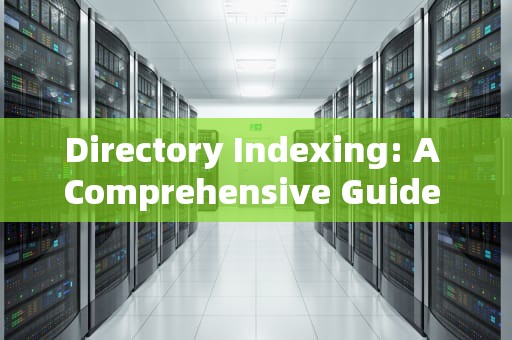In the realm of computing, where data management forms the backbone of efficient operations, directory indexing emerges as a pivotal concept. It's akin to the Dewey Decimal System in libraries, meticulously categorizing and arranging files within a file system to facilitate seamless access and retrieval. This article delves into the intricacies of directory indexing, exploring its mechanisms, benefits, challenges, and best practices.

The Essence of Directory Indexing
At its core, a directory index is a structured listing of files and subdirectories contained within a particular directory on a computer system or network storage. Think of it as an electronic table of contents that provides users with a quick overview of what resides within a specific folder without having to delve into each individual item. Just like how an index at the back of a book helps readers locate topics efficiently, a directory index streamlines navigation through digital information repositories.
How It Works
When a user accesses a directory, the operating system or file manager application generates the directory index by scanning the contents of that directory. This process involves reading metadata associated with each file, such as its name, size, creation date, modification date, permissions, and sometimes even a brief preview or icon representing the file type. The collected information is then presented in a user-friendly format, typically a list or grid view, allowing users to sort, filter, and search for items based on their attributes.
Behind the scenes, directory indexes are often implemented using data structures like B-trees or hash tables, which optimize search times and ensure efficient insertion and deletion operations. These structures maintain a hierarchical organization, reflecting the nested nature of directories and subdirectories, enabling rapid traversal from the root directory to any desired location within the file system.
Benefits of Directory Indexing
1、Enhanced User Experience: By presenting a clear and organized view of directory contents, users can quickly identify the files they need, reducing time spent navigating through complex file hierarchies. This is particularly beneficial in scenarios where users handle large volumes of data or work in collaborative environments with numerous shared files.
2、Improved Productivity: Efficient directory indexing accelerates workflow by minimizing the time required for file searches and access. Professionals in fields like graphic design, video editing, and software development, who frequently manipulate multiple files, can significantly boost their productivity with well-structured directory indexes.
3、Data Management and Organization: Directory indexing encourages good data management practices by promoting the use of descriptive filenames, consistent folder structures, and proper file categorization. This not only aids personal organization but also facilitates collaboration and knowledge sharing within teams and organizations.
4、Security and Access Control: Many directory indexing systems integrate with permission settings, displaying only those files and directories that a user has been granted access to. This ensures data privacy and security, preventing unauthorized access to sensitive information.
Challenges and Considerations
While directory indexing offers numerous advantages, it also presents some challenges that need to be addressed:
1、Performance Overhead: Maintaining up-to-date directory indexes, especially in large file systems with frequent changes, can impose a performance burden on the system. Efficient algorithms and caching mechanisms are crucial to minimize this impact.
2、Consistency Across Platforms: Different operating systems and applications may implement directory indexing differently, leading to inconsistencies in user experience when switching between platforms. Standardization efforts can help alleviate this issue.
3、Handling Large Datasets: As datasets grow exponentially, scalable directory indexing solutions become imperative. Techniques like distributed indexing and load balancing are employed to manage vast amounts of metadata efficiently.
4、User Interface Design: The effectiveness of directory indexing is heavily influenced by the design of the user interface. Intuitive layouts, customizable views, and powerful search functionalities enhance usability and user satisfaction.
Best Practices for Effective Directory Indexing
To harness the full potential of directory indexing, consider adopting these best practices:
1、Consistent Naming Conventions: Establish clear and consistent naming conventions for files and directories to facilitate easy identification and sorting. Include relevant keywords, version numbers, and dates where appropriate.
2、Hierarchical Structure: Organize files into a logical hierarchy of directories and subdirectories based on project, category, or purpose. This mirrors the way humans think and makes navigation more intuitive.
3、Regular Maintenance: Periodically review and clean up directory contents, removing obsolete files and consolidating related items. This keeps the directory index lean and relevant.
4、Leverage Tagging and Metadata: Utilize tags, labels, or extended metadata to further categorize files beyond just their location in the directory structure. This adds another layer of searchability and context.
5、Backup and Recovery Planning: Ensure that directory indexes themselves are backed up along with the files they reference. In case of data loss or corruption, having a recent copy of the index can expedite recovery processes.
6、Training and Education: Educate users on effective directory management strategies and the capabilities of their chosen file manager or operating system. This empowers them to make full use of directory indexing features.
In conclusion, directory indexing stands as a cornerstone of efficient data management in modern computing environments. By understanding its principles, leveraging its benefits, addressing its challenges, and adhering to best practices, individuals and organizations can unlock enhanced productivity, improved data organization, and streamlined workflows. As technology continues to evolve, so too will the sophisticated mechanisms underlying directory indexing, further transforming how we interact with digital information.
随着互联网的普及和信息技术的飞速发展台湾vps云服务器邮件,电子邮件已经成为企业和个人日常沟通的重要工具。然而,传统的邮件服务在安全性、稳定性和可扩展性方面存在一定的局限性。为台湾vps云服务器邮件了满足用户对高效、安全、稳定的邮件服务的需求,台湾VPS云服务器邮件服务应运而生。本文将对台湾VPS云服务器邮件服务进行详细介绍,分析其优势和应用案例,并为用户提供如何选择合适的台湾VPS云服务器邮件服务的参考建议。

工作时间:8:00-18:00
电子邮件
1968656499@qq.com
扫码二维码
获取最新动态
